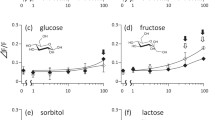Summary
2,5-Anhydro-d-mannitol with a fixed furanose ring stimulated the sugar receptor of the flesh fly (Fig. 1) and reacted with the furanose site (Fig. 3). This is the first direct evidence that a furanose can stimulate the sugar receptor and supports strongly the assumption thatβ-d-fructofuranose is the only stimulatory component in the solution ofd-fructose.
Rigid stereospecificity of the furanose site in the sugar receptor is discussed according to the effectiveness of various synthetic 2,5-anhydro-d-hexitols and related compounds (Table 2, Fig. 6).
At least four receptor sites are concluded to be in a single sugar receptor: a pyranose (P) site, a furanose (F) site, an aliphatic carboxylate (R) site and an aromatic amino acid (Ar) site.
Similar content being viewed by others
References
Buck JB (1953) Physical properties and chemical composition of insect blood. In: Roeder KD (ed) Insect physiology. John Wiley and Sons, New York, p 147
Hanamori T, Shiraishi A, Kijima H, Morita H (1974) Structure of monosaccharides effective in stimulation of the sugar receptor of the flesh fly. Chem Sens Flavour 1:147–166
Jakinovich W Jr, Goldstein IJ, Baumgarten RJ von, Agranoff BW (1971) Sugar receptor specificity in the fleshfly,Sarcophaga bullata. Brain Res 35:369–378
Morita H, Yamashita S (1959) Generator potential of insect chemoreceptor. Science 130:922
Ohrui H, Horiki H, Meguro H, Shimada I (1985) The sweet taste responses of fly to furanoses and their analogues. Agric Biol Chem (in press)
Shimada I, Isono K (1978) The specific receptor site for aliphatic carboxylate anion in the labellar sugar receptor of the fleshfly. J Insect Physiol 24:807–811
Shimada I, Tanimura T (1981) Stereospecificity of multiple-receptor sites in a labellar sugar receptor for amino acids and small peptides. J Gen Physiol 77:23–39
Shimada I, Shiraishi A, Kijima H, Morita H (1974) Separation of two receptor sites in a single labellar sugar receptor of the fleshfly by treatment withp-chloromercuribenzoate. J Insect Physiol 20:605–621
Shiraishi A, Kuwabara M (1970) The effects of amino acids on the labellar hair chemosensory cells of the fly. J Gen Physiol 56:768–782
Wieczorek H (1980) Sugar reception by an insect water receptor. J Comp Physiol 138:167–172
Wieczorek H, Köppl R (1978) Effect of sugars on the labellar water receptor of the fly. J Comp Physiol 126:131–136
Wilczek M (1967) The distribution and neuroanatomy of the labellar sense organs of the blowflyPhormia regina Meigen. J Morphol 122:175–201
Author information
Authors and Affiliations
Rights and permissions
About this article
Cite this article
Shimada, I., Horiki, H., Ohrui, H. et al. Taste response to 2,5-anhydro-d-hexitols; rigid stereospecificity of the furanose site in the sugar receptor of the flesh fly. J. Comp. Physiol. 157, 477–482 (1985). https://doi.org/10.1007/BF00615148
Accepted:
Issue Date:
DOI: https://doi.org/10.1007/BF00615148




